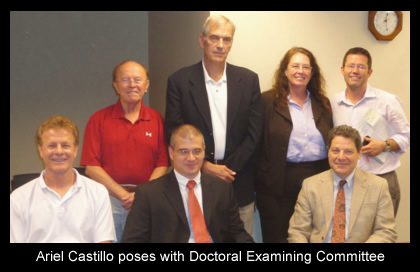Two outstanding doctoral candidates successfully defended their doctoral dissertation research over the spring and fall 2011 semesters.
Ariel S. Castillo
On September 13, 2011, Ariel S. Castillo defended his dissertation entitled “Determination of Solar Energy Transition Potential of Large Organizations: An Application to Department of Defense Facilities and Non-Tactical Vehicles.” Ariel, whose research was financially sponsored by the Solar Institute, previously received his undergraduate degree from the University of Notre Dame, where he graduated in May 2000, and his master’s degree from the University of Dayton, where he graduated in May 2003.
In his research, Ariel developed an objective and systematic approach to determining the renewable energy (specifically solar) transition potential of large organizations. The research focused on the Department of Defense (DoD) test bed to portray the current DoD energy landscape, conduct a DoD benefits analyses for solar energy implementation and develop a multi-criteria decision model for solar implementation on DoD bases the US. While the research focused on a DoD test bed, the results are expected to impact a broader landscape to include other public and private sector entities in the US and globally.
A multi-criteria decision-aiding model developed in the research evaluated parameter data for 200 DoD bases in the US. Data used included energy, environmental, technical, cost, and mission parameters. The model assessed fossil energy consumption, CO2 emissions, amount of land necessary to meet base-level fossil energy consumption and cost of solar implementation. Parameter preference values and subject matter expert weights were used to develop scores for relevant energy, environmental, technical, cost and mission parameters. The multi-criteria decision model resulted in an ordinal ranking of 200 DoD bases in terms of prospects for solar energy implementation.
The results across the 200 sampled DoD bases indicated production of 34.2 million MWh per year of fossil energy consumption and 28.5 million metric tons per year of CO2 emissions that could be offset by solar energy technologies at a cost of $82.2 billion and requiring 0.82% of the total land area of the sampled bases. A depiction of the solar energy potential across the 200 DoD sampled bases is located below.
Leon Adams
On May 10, 2011, Leon Adams defended his dissertation entitled “Uncertainly Analysis Applications of Generalized Diagonal Band Copula with Two-Sided Power Generating Densities.”

Leon previously received a Bachelor of Science degree in Mechanical Engineering from the San Jose State University, where he graduated in May 2000, and a Master of Engineering degree in Mechanical Engineering from the University of Maryland, where he graduated in August 2005.
In his research, Leon developed a novel multivariate model based on copula dependence functions and common risk factors, and used it to examine datasets characterizing rainfall return periods of the Seoul, Gangneung, and Jecheon watersheds in South Korea. Hydrological events are often times associated with great loss. Such losses are realized in terms of human casualties and indeed their financial impact. A better understanding of these events can inform better adaptation strategies to lessen the impact of these natural phenomena.
Copulas result from the study of probability metric spaces that possess the ability of generating multivariate distributions coupled together from their univariate marginals. Leon’s work adds to the current copula literature a new multivariate copula framework with reduced parameter estimation burden by utilizing a common risk factor approach. Presently, there are only three broad categories of copula families that dominate in scholarly works: Elliptical copulas due to their familiarity in current statistical models (e.g. the Gaussian copula); Archimedean copulas due to their mathematically tractability; and Extreme Value copulas which are useful when the subject matter being studied is extreme valued.
Although the potential for the adoption of copulas in statistical analysis is high, actual implementation of copula models often is limited to these three copula families. The current multivariate model is significant in that it offers an alternate multivariate copula model with a straightforward sampling procedure, the use of which can aid in the further adoption of copulas in statistical dependence applications.
Leon’s research results were submitted to an Elsevier peer-reviewed journal. A copy of his manuscript can be seen by clicking on the following link: Adams. L. and van Dorp, J.R., “Hydrological Frequency Analysis Using the Generalized Diagonal Band Two-Sided Power Copula Model.”
Leon’s research was directed by Professor Johan R. van Dorp. The Examining Committee for his research consisted of EMSE faculty members Dr. Enrique Campos-Nanez, Dr. Thomas Mazzuchi, Dr. Jonathan Deason and Dr. Johan R. van Dorp; and an external expert.


